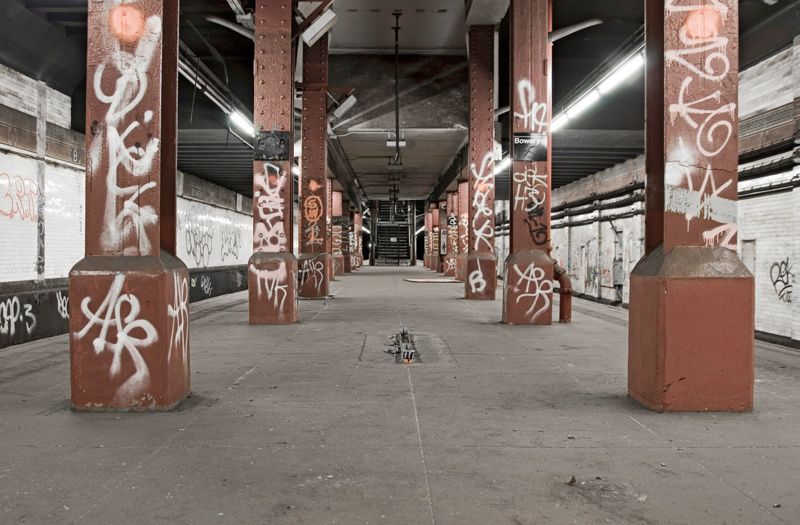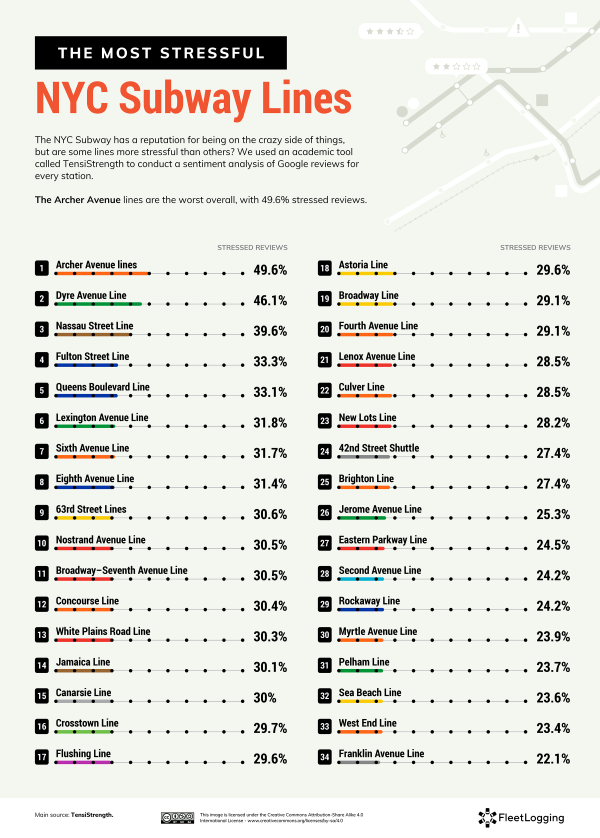100th Anniversary Great Nave Tour at the Cathedral of St. John the Divine
Celebrate the 1925 construction of the stunning nave inside the world's largest Gothic cathedral!


For many New Yorkers, subway stations have likely caused quite a bit of stress, From extremely hot interiors to rats running aimlessly to lack of cleanliness, some of the city’s subways have led many to feel aggravated and irritated. And with the return to public transit while still in a pandemic, many New Yorkers are likely fearful of every station. But a new study from FleetLogging has determined New York City’s most stressful subway station, and some of these might be rather surprising.
FleetLogging used TensiStrength, an academic tool that measures the stress levels of text, to assess which train stations and metro lines have the largest percentage of stressed reviews on Google Maps. The study found that the most stressful subway stations in the world are located in Minsk, Belarus, and Prague, Czechia, both with 100% stress rates. Elgin in Chicago was the most stressful subway station in the U.S. at about 50%, while Juárez, Mexico is the highest in North America at 58%.
The moment we’ve all been waiting for, though, is the most stressful subway station in New York City — according to the study, “The Subway in NYC is known to be a little wild at the best of times, but some stops are crazier than others.” The honor — or dishonor — goes to Jamaica Center-Parsons/Archer station on the Archer Avenue lines, with 66.7% of reviews brimming with frustration.

The station in Jamaica, Queens, is served by the E and J trains at all times, as well as the Z train during rush hours in the peak direction. The station is a major transfer point for buses from eastern Queens, and it was constructed in 1988 with one of the largest ridership of any station in the city. The station was also the subject of an art controversy in 1991. A display titled “Astoria–Dreams of New York,” a 32-foot-long mural consisting of seven portraits of first-generation Greek immigrants, was removed from the station for not including any African Americans. After a few months of debates, it was reinstalled, with a banner reading “Portraits of the Greek Immigrant Community” added in addition to the tile.
According to the study, the station was considered the most stressful subway station since it is “Dirty… Smelly… Overcrowded Subway… Guys hanging around harassing me and other women…” A stress score of 66.7% put the station over 63.6% at Burke Avenue Station in second place. The Burke Avenue Station in the Bronx is served by the 2 train at all times and by the 5 train during rush hours. The station was opened in 1917, and it features a stained glass artwork called Bronx Literature by Béatrice Coron.
Just slightly behind the Burke Avenue Station is the 67th Avenue station in Forest Hills along Queens Boulevard, served by the M train on weekdays, the R train at all times except nights and the E train at night. The station, in part financed by a Works Progress Administration loan, opened in 1936 and was scheduled to undergo a complete overhaul a few years ago; however, lack of funding prevented any improvements to the station, including improved signage and station lighting, as well as cellular service and Wi-Fi.
Among those just below 60% stress rates are Bowery (and see inside the abandoned Bowery subway station), Canal Street, Sixth Avenue, Clinton-Washington Avenues, Nassau Avenue, President Street-Medgar Evers College and Sheepshead Bay.

When looking at the most stressful NYC Subway lines, the Archer Avenue line (which includes Jamaica Center-Parsons/Archer station) once again claimed victory at 49.6%. This score was so high because Jamaica–Van Wyck station also scores a 48.4%. The runner-up was the Dyre Avenue Line at 46.1%, which passes through the northeastern part of the Bronx along the 5. The line is actually the only remaining portion of the New York, Westchester and Boston Railway that opened in 1912.

Among those over 30% stress ratings are the Nassau Street Line in lower Manhattan, the Fulton Street Line through Central Brooklyn, the Queens Boulevard Line, the Lexington Avenue Line and the Sixth Avenue Line. The least stressful is the Franklin Avenue Line thanks to stations like Prospect Park, which has an outdoor location, greenery, ticket kiosks and a modern elevator.
Now you know that you’re not alone in expressing frustration with many of the city’s subway stations and lines. And for a handful of stations, you might be in the majority of riders who share this sentiment.
Next, check out the Top 20 Secrets of the NYC Subway!
Subscribe to our newsletter